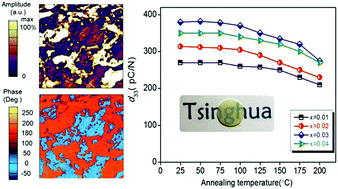当前位置:
X-MOL 学术
›
J. Mater. Chem. C
›
论文详情
Our official English website, www.x-mol.net, welcomes your
feedback! (Note: you will need to create a separate account there.)
Niobate-based lead-free piezoceramics: a diffused phase transition boundary leading to temperature-insensitive high piezoelectric voltage coefficients†
Journal of Materials Chemistry C ( IF 5.7 ) Pub Date : 2018-01-02 00:00:00 , DOI: 10.1039/c7tc04813k Qing Liu 1, 2, 3, 4, 5 , Jing-Feng Li 1, 2, 3, 4, 5 , Lei Zhao 1, 2, 3, 4, 5 , Yichi Zhang 1, 2, 3, 4, 5 , Jing Gao 1, 2, 3, 4, 5 , Wei Sun 1, 2, 3, 4, 5 , Ke Wang 1, 2, 3, 4, 5 , Longtu Li 1, 2, 3, 4, 5
Journal of Materials Chemistry C ( IF 5.7 ) Pub Date : 2018-01-02 00:00:00 , DOI: 10.1039/c7tc04813k Qing Liu 1, 2, 3, 4, 5 , Jing-Feng Li 1, 2, 3, 4, 5 , Lei Zhao 1, 2, 3, 4, 5 , Yichi Zhang 1, 2, 3, 4, 5 , Jing Gao 1, 2, 3, 4, 5 , Wei Sun 1, 2, 3, 4, 5 , Ke Wang 1, 2, 3, 4, 5 , Longtu Li 1, 2, 3, 4, 5
Affiliation

|
One of the key remaining challenges for the most promising Pb-free (K,Na)NbO3 (KNN) piezoelectrics is how to improve the temperature stability of piezoelectric voltage coefficients, which is vital to promoting their practical applications. This study proposes an effective approach to develop highly piezoelectric KNN-based ceramics with temperature-insensitive piezoelectric voltage coefficients (d33), which is also called direct piezo-coefficient, by broadening the boundaries from tetragonal to orthorhombic and then to rhombohedral phases. The Li-doped KNN ceramics modified with BaZrO3 and (Bi,Zr)TiO3 exhibit a high d33 up to 330 pC N−1, whose variation is limited to ±10% in a common application temperature range (25–100 °C), when their composition is optimized for strengthening their temperature stability. A high d33 up to 380 pC N−1 with a larger variation (<20%) but in a wider temperature range (25–200 °C) was also available in the present materials possessing a large planar electromechanical coupling coefficient kp up to 0.54 and a high Curie temperature of >260 °C as well as high strength associated with high relative density. Piezoelectric force microscopy (PFM) studies reveal that the good piezoelectric response could be related to the easier domain reorientation and domain wall motion. The present results validated that our approach based on phase transition boundary engineering should be an effective strategy for further development of high-performance lead-free piezoceramics towards the demand for industrial applications.
中文翻译:

铌酸盐基无铅压电陶瓷:扩散的相变边界导致对温度不敏感的高压电电压系数†
对于最有前途的无铅(K,Na)NbO 3(KNN)压电而言,关键的剩余挑战之一是如何提高压电电压系数的温度稳定性,这对于促进其实际应用至关重要。这项研究提出了一种有效的方法,通过扩大从四方相到正交相再到菱面相的边界,来开发对温度不敏感的压电电压系数(d 33)的高度压电KNN基陶瓷,也称为直接压电系数。用BaZrO 3和(Bi,Zr)TiO 3改性的掺锂KNN陶瓷的最高d 33高达330 pC N -1当优化其成分以增强其温度稳定性时,在通常的应用温度范围(25–100°C)下,其变化限制在±10%。在具有较大平面机电耦合系数k p的本材料中,也可以使用高达d 33的高d 33至380 pC N -1(较大的变化(<20%),但在较宽的温度范围(25-200°C)中使用最高可达0.54,居里温度高于260°C,并且具有与高相对密度相关的高强度。压电显微镜(PFM)研究表明,良好的压电响应可能与域重定向和域壁运动更容易有关。目前的结果证实了我们基于相变边界工程的方法应该是针对工业应用需求进一步开发高性能无铅压电陶瓷的有效策略。
更新日期:2018-01-02
中文翻译:

铌酸盐基无铅压电陶瓷:扩散的相变边界导致对温度不敏感的高压电电压系数†
对于最有前途的无铅(K,Na)NbO 3(KNN)压电而言,关键的剩余挑战之一是如何提高压电电压系数的温度稳定性,这对于促进其实际应用至关重要。这项研究提出了一种有效的方法,通过扩大从四方相到正交相再到菱面相的边界,来开发对温度不敏感的压电电压系数(d 33)的高度压电KNN基陶瓷,也称为直接压电系数。用BaZrO 3和(Bi,Zr)TiO 3改性的掺锂KNN陶瓷的最高d 33高达330 pC N -1当优化其成分以增强其温度稳定性时,在通常的应用温度范围(25–100°C)下,其变化限制在±10%。在具有较大平面机电耦合系数k p的本材料中,也可以使用高达d 33的高d 33至380 pC N -1(较大的变化(<20%),但在较宽的温度范围(25-200°C)中使用最高可达0.54,居里温度高于260°C,并且具有与高相对密度相关的高强度。压电显微镜(PFM)研究表明,良好的压电响应可能与域重定向和域壁运动更容易有关。目前的结果证实了我们基于相变边界工程的方法应该是针对工业应用需求进一步开发高性能无铅压电陶瓷的有效策略。










































 京公网安备 11010802027423号
京公网安备 11010802027423号